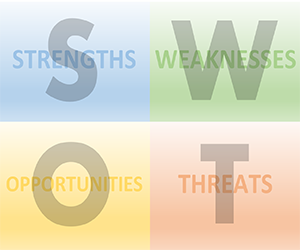
Want to make smarter decisions in business, project management, or even your personal life?
A SWOT Analysis is your go-to tool for gaining a competitive edge. By weighing your strengths against competitors’ weaknesses and evaluating opportunities versus threats, this method clarifies the best path forward.
From portfolio managers choosing high-impact projects with limited budgets to project managers prioritizing deliverables, SWOT Analysis brings laser focus to decision-making. By blending internal factors (strengths and weaknesses) with external ones (opportunities and threats), it empowers you to craft strategies that win, honing your leadership qualities in the meantime.
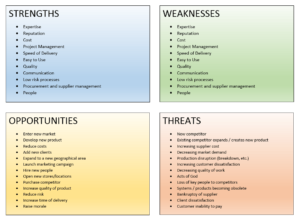 It is normally plotted on a 2 x 2 matrix.
It is normally plotted on a 2 x 2 matrix.
SWOT stands for:
- Strengths
- Weaknesses
- Opportunities
- Threats
Step 1: Set up a 2 x 2 Matrix
Any blank piece of paper works well. A spreadsheet or MS Word software will work just as well.
Divide the page into four blanks quadrants.
Step 2: Strengths
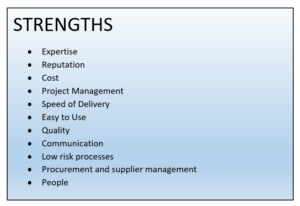 The top left quadrant of the SWOT analysis contains the elements that your organization or project team excels at. The best source of this information is customers or clients if you are in a position to ask them, but even if you aren’t I would suggest you can get a pretty decent SWOT analysis anyway.
The top left quadrant of the SWOT analysis contains the elements that your organization or project team excels at. The best source of this information is customers or clients if you are in a position to ask them, but even if you aren’t I would suggest you can get a pretty decent SWOT analysis anyway.
Use this checklist to assist in brainstorming to find your strengths:
- What have we excelled at in the past?
- What have others said that we have excelled at?
- What awards have we won?
- What resources, equipment or facilities do we have that others don’t?
- What can you do cheaper than others?
Step 3: Weaknesses
 Underperformance in an organization is often ignored or kept quiet, but can be the missing link that causes the company to turn its fortunes around. The top right quadrant is for listing your weaknesses. The checklist questions are:
Underperformance in an organization is often ignored or kept quiet, but can be the missing link that causes the company to turn its fortunes around. The top right quadrant is for listing your weaknesses. The checklist questions are:
- Think of your top 3 project failures. What was the principle cause?
- What criticism have you received from others?
- What business relationships, clients, or customers have you lost? Why did you lose them?
- What internal conflicts has your organization experienced?
- What sales have you lost?
Step 4: Opportunities
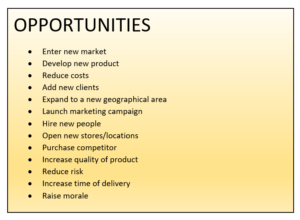 Opportunities are the actions the organization could do that are most likely to succeed in achieving the organization’s goals. They are found in the bottom left quadrant of the SWOT analysis, and they fall into the categories of:
Opportunities are the actions the organization could do that are most likely to succeed in achieving the organization’s goals. They are found in the bottom left quadrant of the SWOT analysis, and they fall into the categories of:
- Economic: The future market demand for the product or service. Changes in interest rates or currency exchange rates. Future products/services from competitors.
- Technological: An increase in sales due to better technology. Also, a decrease in costs to produce the product, or a better competitive position because of fast rollout of technology.
- Social: Demographics, such as population shifts, and attitudes toward issues such as health and wellness. Irrational market ‘love’ of certain products.
- Political: The tax environment and tariffs. Opportunities from future changes in regulations.
Here are five questions for the opportunities quadrant.
- What are the three biggest changes in your industry recently?
- What technology has opened new doors?
- How can you reduce costs in your existing business?
- What trends are occurring in your market (lifestyle, demographic, etc.)?
- What new products have your competitors pursued?
Step 5: Threats
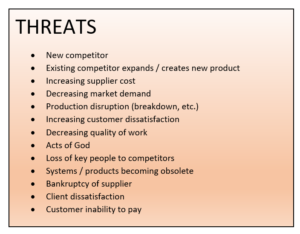 These are the potential negative effects from factors outside the organization’s control. A strong corporate strategy requires a strong analysis of threats and related action plans. Threats can be classified as internal or external.
These are the potential negative effects from factors outside the organization’s control. A strong corporate strategy requires a strong analysis of threats and related action plans. Threats can be classified as internal or external.
- Internal: Employees leaving, equipment breaking down, harmful corporate reorganization, decreasing quality of work, loss of client relationships.
- External: Market demand, increasing supplier costs, systems and processes becoming obsolete, technological factors, acts of God.
Here is the checklist for the Threats quadrant:
- Where have you recently lost business?
- What changes have occurred in your industry that could result in lost business?
- Which competitors are your biggest threat?
- Which part of your business is the most valuable?
- Which part of your business is the most under threat (likely to decrease)?
Example
This example shows the types of things that one might put into the 4 quadrants of the SWOT analysis matrix:
SWOT Analysis Template
Please try our free SWOT Analysis template. It also includes a handy checklist for the typical types of things you might see in the matrix.
Let us all know in the comments how you’ve used a SWOT analysis and share some of your amazing (hopefully) results. We’d love to hear from you.











Leave a Reply